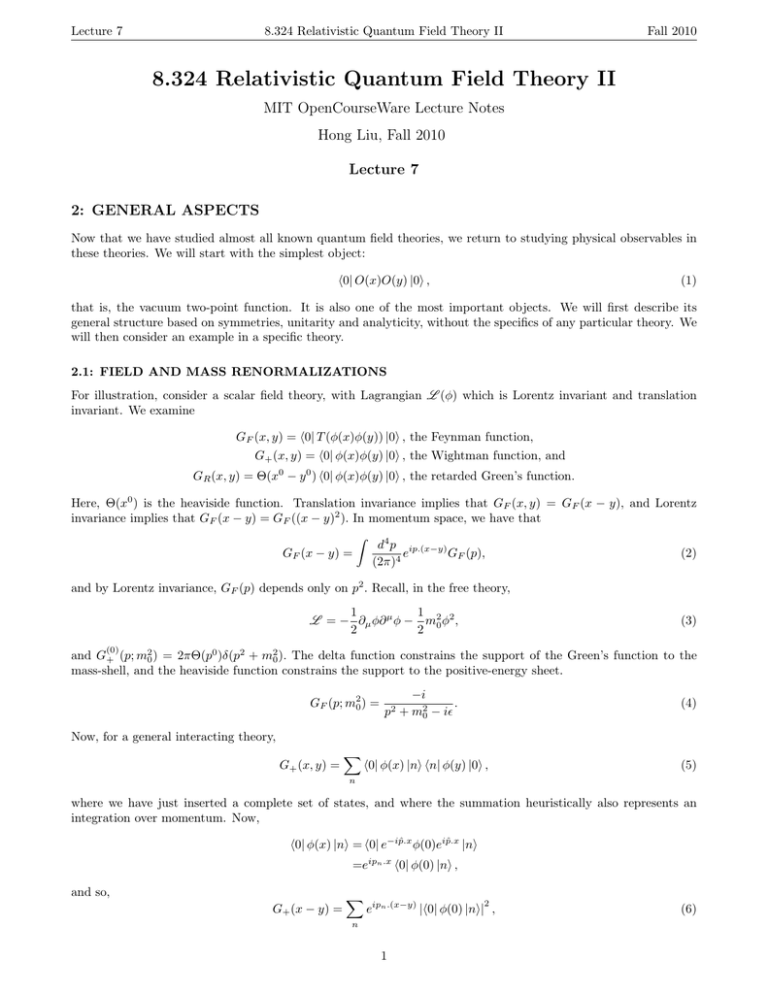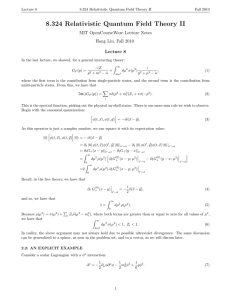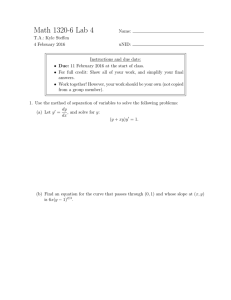Document 13650476
advertisement

Lecture 7 8.324 Relativistic Quantum Field Theory II Fall 2010 8.324 Relativistic Quantum Field Theory II MIT OpenCourseWare Lecture Notes Hong Liu, Fall 2010 Lecture 7 2: GENERAL ASPECTS Now that we have studied almost all known quantum field theories, we return to studying physical observables in these theories. We will start with the simplest object: ⟨0| O(x)O(y) |0⟩ , (1) that is, the vacuum two-point function. It is also one of the most important objects. We will first describe its general structure based on symmetries, unitarity and analyticity, without the specifics of any particular theory. We will then consider an example in a specific theory. 2.1: FIELD AND MASS RENORMALIZATIONS For illustration, consider a scalar field theory, with Lagrangian L (ϕ) which is Lorentz invariant and translation invariant. We examine GF (x, y) = ⟨0| T (ϕ(x)ϕ(y)) |0⟩ , the Feynman function, G+ (x, y) = ⟨0| ϕ(x)ϕ(y) |0⟩ , the Wightman function, and GR (x, y) = �(x0 − y 0 ) ⟨0| ϕ(x)ϕ(y) |0⟩ , the retarded Green’s function. Here, �(x0 ) is the heaviside function. Translation invariance implies that GF (x, y) = GF (x − y), and Lorentz invariance implies that GF (x − y) = GF ((x − y)2 ). In momentum space, we have that ˆ d4 p ip.(x−y) GF (x − y) = e GF (p), (2) (2π)4 and by Lorentz invariance, GF (p) depends only on p2 . Recall, in the free theory, 1 1 L = − ∂µ ϕ∂ µ ϕ − m20 ϕ2 , 2 2 (3) (0) and G+ (p; m20 ) = 2π�(p0 )δ(p2 + m20 ). The delta function constrains the support of the Green’s function to the mass-shell, and the heaviside function constrains the support to the positive-energy sheet. GF (p; m20 ) = −i . p2 + m20 − iϵ (4) Now, for a general interacting theory, G+ (x, y) = ∑ ⟨0| ϕ(x) |n⟩ ⟨n| ϕ(y) |0⟩ , (5) n where we have just inserted a complete set of states, and where the summation heuristically also represents an integration over momentum. Now, ˆ ˆ ⟨0| ϕ(x) |n⟩ = ⟨0| e−ip.x ϕ(0)eip.x |n⟩ =eipn .x ⟨0| ϕ(0) |n⟩ , and so, G+ (x − y) = ∑ 2 eipn .(x−y) |⟨0| ϕ(0) |n⟩| , n 1 (6) Lecture 7 8.324 Relativistic Quantum Field Theory II or, more explicitly, ˆ G+ (x − y) = Fall 2010 ∑ d4 p ip.(x−y) 2 4 e (2π) δ (4) (p − pn ) |⟨0| ϕ(0) |n⟩| . (2π )4 n (7) ∑ 2 We define (2π)�(p0 )ρ(−p2 ) = (2π)4 n δ (4) (p − pn ) |⟨0| ϕ(0) |n⟩| , a Lorentz invariant scalar function of p, with ρ(−p2 ) = 0 for p2 > 0, as all |n⟩ should have En = p0n > 0, and so p2n < 0. We thus find that G+ (p) =2π�(p0 )ρ(−p2 ) ˆ � = dµ2 2πδ(p2 + µ2 )�(p0 )ρ(µ2 ), 0 and so, for an interacting theory, we obtain the general result: ˆ � (0) G+ (p) = dµ2 ρ(µ2 )G+ (p; µ2 ) 0 ˆ � (0) G+ (x − y) = dµ2 ρ(µ2 )G+ (x − y; µ2 ) 0 where ρ(µ2 ) is the spectral function. Now we consider the structure of ρ(−p2 ). We have that (2π)�(p0 )ρ(−p2 ) = ∑ ∑ 2 (2π)4 n δ (4) (p − pn ) |⟨0| ϕ(0) |n⟩| , where n is a sum over all physical states: that is, a sum over single-particle states and multi-particle states. Firstly, ∑ ∑ ˆ d3⃗k 1 = (2π)3 2ωk i single-particle states ∑ ˆ d4 k = 2πδ(k 2 + m2i ), 4 (2 π ) i √ m2i + ⃗k 2 . Other than the m2i , this sum is completely determined by Lorentz symmetry. Now, we consider the multi-particle states. For a given ⃗k, a continuum of ω are allowed. For example, for a two-particle state at ⃗k = 0, where i indexes the particle species, and ωk = k2= -k1 k1 Figure 1: A two particle-state with zero total momentum. √ ω= k12 + m21 + √ k22 + m22 , ω forms a continuum starting at m1 + m2 , and so, k 2 starts at −(m1 + m2 )2 . We thus find ∑ ˆ d4 k 2 (2π)�(p0 )ρ(−p2 ) = 2πδ(k 2 + m2i )�(k 0 )(2π)4 δ (4) (p − k) |⟨0| ϕ(0) |k, i⟩| + 2π�(p0 )σ(−p2 ) 4 (2 π ) i where the second term is the contribution from multi-particle states. Hence, we have that ∑ ρ(−p2 ) = σ(−p2 ) + δ(p2 + m2i )Zi (8) (9) (10) i 2 with Zi = |⟨0| ϕ(0) |k, i⟩| a number which is independent of k, since k 2 = −m2i . σ(−p2 ) is non-zero for −p2 ≥ 4m21 , where m1 is the smallest single-particle mass. So, for the Feynman function, we have ˆ � ∑ −iZj −i GF (p) = + dµ2 σ(µ2 ) 2 . (11) 2 + m2 − iϵ 2 p p + µ2 − iϵ 4m1 j j It is convenient to introduce a function defined for a general complex parameter s, ˆ � ∑ −iZj −i �(s) ≡ + dµ2 σ(µ2 ) . 2 s − mj s − µ2 4m21 j 2 (12) Lecture 7 8.324 Relativistic Quantum Field Theory II Fall 2010 Then GF (p2 ) = �(s = −p2 + iϵ), and so, we obtain the Feynman function by approaching the real s−axis from above. We observe two features of �(s) : 1. �(s) has poles at single-particle mass-squared values: s = m2j . 2. There is a branch cut beginning at 4m21 with a discontinuity �(r + iϵ) − �(r − iϵ) = 2πσ(r). Im(s) m21 m22 4m12 r Re(s) Figure 2: The function �(s) plotted on the complex plane. Now, consider 1 1 L = − ∂µ ϕ∂ µ ϕ − m20 ϕ2 + LI (ϕ, λ), 2 2 (13) −i and suppose that as λ −→ 0, L −→ 0. At λ = 0, GF (p) = p2 +m 2 −iϵ . If ϕ does not have any bound states, then, 0 for λ ̸= 0, we have ˆ � −iZ i GF (p) = 2 + dµ2 σ(µ2 ) 2 . (14) p + m2 − iϵ p + µ2 − iϵ 4m2 (0) In general, we note the following points: 1. m2 ̸= m20 : we have a mass renormalization. m20 , the bare mass which appears in the Lagrangian, is not necessarily m2 , the physical mass which appears in the propagator. 2. Z ̸= 1: we have a field-strength renormalization. Z = |⟨0| ϕ(0) |k⟩| . These first two points are generic to interactions, and have nothing to do with ultraviolet divergences. 3. ϕ(0) |0⟩ also generates multiple-particle states. √ 2 We define ϕphys ≡ Zϕ, meaning |⟨0| ϕphys (0) |k⟩| = 1. 4. 2 3 MIT OpenCourseWare http://ocw.mit.edu 8.324 Relativistic Quantum Field Theory II Fall 2010 For information about citing these materials or our Terms of Use, visit: http://ocw.mit.edu/terms.









